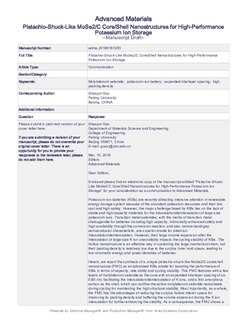Pistachio‐Shuck‐Like MoSe2/C Core/Shell Nanostructures for High‐Performance Potassium‐Ion Storage
Wang, Wei; Jiang, Bo; Qian, Chang; Lv, Fan; Feng, Jianrui; Zhou, Jinhui; Wang, Kai; Yang, Chao; Yang, Yong; Guo, Shaojun
Journal article, Peer reviewed
Accepted version

Åpne
Permanent lenke
http://hdl.handle.net/11250/2590860Utgivelsesdato
2018Metadata
Vis full innførselSamlinger
- Institutt for materialteknologi [2527]
- Publikasjoner fra CRIStin - NTNU [37703]
Sammendrag
Potassium‐ion batteries (KIBs) have recently attracted intensive attention because of the abundant potassium resources and their low cost and high safety. However, the major challenge faced by KIBs lies in the lack of stable and high‐capacity materials for the intercalation/deintercalation of large‐size potassium ions. A unique pistachio‐shuck‐like MoSe2/C core/shell nanostructure (PMC) is synthesized herein as an advanced anode for boosting the performance of KIBs. This PMC is featured with a few layers of molybdenum selenide as the core with an expanded interlayer spacing of ≈0.85 nm, facilitating the intercalation/deintercalation of K ions, and a thin amorphous carbon as the shell, which can confine the active molybdenum selenide nanosheets during cycling for maintaining the high structural stability. Most importantly, as a whole, the PMC has the advantages of reducing the surplus hollow interior space for improving its packing density and buffering the volume expansion during the K‐ion intercalation for further enhancing the stability. As a consequence, the PMC shows a very high capacity of 322 mAh g−1 at 0.2 A g−1 over 100 cycles, and can still remain 226 mAh g−1 at 1.0 A g−1 for a long period of 1000 cycles, which is among the best‐reported KIBs anodes.